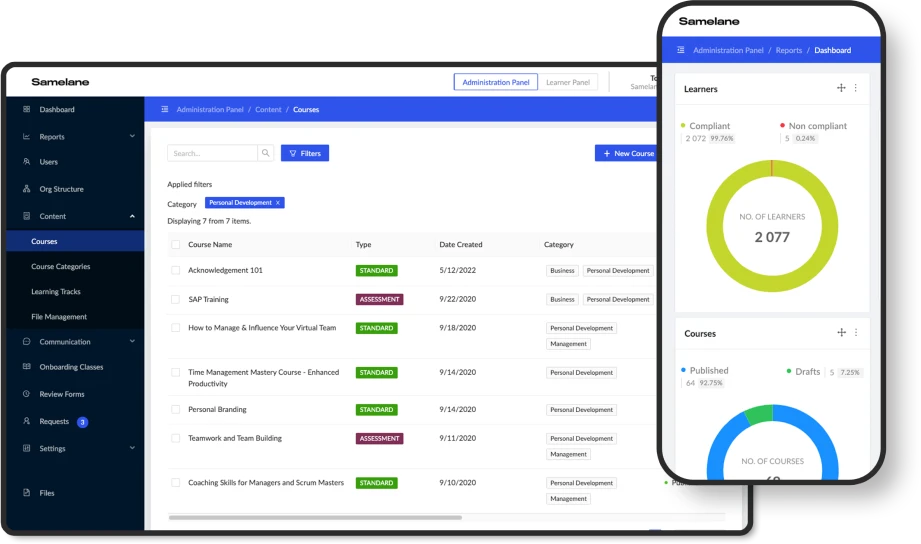Knowledge management in a company is an extremely important process which requires a strategic approach, as well as the creation of a favorable organizational culture and system infrastructure that facilitates the generation of knowledge, its accumulation, and subsequent transfer. Without a doubt, the most important aspect of knowledge management in an enterprise is its transfer within a specific group of employees or within the entire structure. Why is spreading knowledge so important today? How to create favorable conditions for employee knowledge sharing process?
What is knowledge sharing?
Sharing knowledge is nothing more than exchanging information or creating shared understanding between at least two parties, which may give knowledge a new context and make it more useful. It facilitates the understanding of, for example, the processes taking place within a company, the specifics of the business itself, or the ways of solving identified problems often encountered in everyday work. It is an organized and deliberate process leading to the dissemination of valuable know-how among specific groups of employees, teams, or entire structures. Why is it important to manage knowledge in an organization? A properly organized knowledge management process primarily leads to improved productivity, but there are many more measurable benefits – to be discussed below.
Knowledge sharing in knowledge management refers to the process of transferring, disseminating, and exchanging knowledge within an organization to enable collective learning and decision-making. It facilitates collaboration, reduces duplication of efforts, and promotes continuous learning and improvement within an organization. By actively promoting employee knowledge sharing, organizations can enhance their overall knowledge management capabilities,
Why is sharing knowledge essential?
By ignoring the experience accumulated over the years, or the vast knowledge of employees, companies expose themselves to large and unnecessary losses. Nowadays, continuous improvement is inscribed in the DNA of every company, so creating an appropriate organizational culture and optimal conditions for sharing knowledge and experience is a necessity. One could even risk saying that it is no longer a chance to stay ahead of the competition, but an effective way to keep pace with it.
What particular changes can effective knowledge management bring to your company? There are undoubtedly many benefits, but the most important ones are as follows:
- Efficient problem solving and decision making
Effective employee knowledge sharing in organizations means that problems encountered in individual areas can be solved much faster. The knowledge base is nothing more than a place for gathering procedures and instructions for dealing with particular problems. If an employee has dealt with a similar situation in the past, it is worth reaching out for their tips and, thus, saving a lot of time by not solving the problem from scratch. There is no economic justification for forcing employees to reinvent the wheel. Thanks to the dissemination of shared knowledge in the company, problems are solved much faster and decision-making processes are significantly shorter. In other words – time is money.
- Improving the quality of services
Many organizations operate under conditions heavily regulated by applicable law. A perfect example is a financial industry, where individual operations must be processed with extreme precision and within strictly defined deadlines. Having appropriate procedures and instructions for individual processes can significantly improve the quality of services and reduce the level of errors to a minimum, thus mitigating the risk related to improper execution of customer instructions. This not only improves the quality of service provision, but also protects the organization from possible financial penalties.
- Knowledge retention within the organization
The HR department of any company does its best to attract the best candidates in the market, ones with extensive experience and desired competencies. It is usually done at a considerable cost, so it is worth taking appropriate steps to ensure that the knowledge they bring is not lost. This also applies to current employees. They are the ones who know the specifics of the business and customer expectations, and they can quickly solve problems, operate corporate systems, and react to crisis situations. By building a shared knowledge base in the company and engaging employees in its creation, key knowledge can be effectively retained and the business can be protected against the negative consequences of high employee turnover.
- Increasing employee engagement
A properly conducted knowledge management process in an organization is, on the one hand, an effective way of securing business continuity, and, on the other, an extremely valuable tool to increase employee involvement. It allows businesses to create experts in the company. It gives employees the feeling that they are important parts of the organization, that they are listened to, and that their knowledge and experience are essential for the management. There is no need to convince anyone about how important and, at the same time, difficult it is to influence the level of employee involvement. Is it worth it? At this point, the words of Richard Branson seem suitable: “Clients do not come first. Employees come first. If you take care of your employees, they will take care of the clients.”*
- Stimulating growth and innovation
The main goal of most companies is to improve financial performance, but the task becomes more difficult the higher the level of competition on the market. In such situations in particular, effective knowledge management allows businesses to grow and, at the same time, stimulate innovation. Without access to a central knowledge base, effective methods of corporate knowledge sharing, or an appropriate organizational culture, this task would be much more difficult.

Examples of knowledge sharing
From multinational corporations to small startups, knowledge sharing processes are being embraced as a means to foster collaboration, enhance employee development, and drive organizational excellence. We have singled out the most effective knowledge sharing examples. Here are the most pupular practices of knowledge sharing in organizations:
Documentation and Manuals: Creating and maintaining comprehensive documentation, manuals, and standard operating procedures (SOPs) to capture and share knowledge within the organization. This can include user guides, technical specifications, and process documentation.
Training Programs: Organizing training sessions, workshops, and seminars to educate employees about specific topics, skills, or technologies. These programs can be conducted by subject matter experts or external trainers to ensure knowledge dissemination.
Mentoring and Coaching: Implementing mentorship or coaching programs where experienced employees provide guidance, support, and knowledge transfer to junior or less experienced colleagues. This helps in transferring tacit knowledge and expertise from seasoned employees to new members.
Knowledge Repositories: Building centralized repositories or knowledge bases where employees can store, organize, and access information, documents, and resources. These repositories can be in the form of intranets, wikis, or content management systems.
Cross-Functional Collaboration: Encouraging collaboration and communication between different departments or teams to facilitate knowledge exchange. This can be achieved through project-based work, cross-functional meetings, or inter-departmental rotations.
Internal Social Networks: Implementing internal social networking platforms where employees can connect, share ideas, ask questions, and collaborate. These platforms can include features like discussion forums, chat groups, and file sharing capabilities.
Recognition and Incentives: Recognizing and rewarding employees who actively contribute to knowledge sharing initiatives. This can include incentives such as bonuses, promotions, or public acknowledgment to encourage a culture of knowledge sharing.
How to transfer knowledge within an organization?
The effective transfer of knowledge in an organization requires, above all, time, people, and appropriate channels of dissemination. It is also necessary to create an appropriate organizational culture within the enterprise, supporting mutual trust, encouraging cooperation, and promoting active staff involvement in the process.
Obstacles to knowledge sharing
Effective knowledge sharing process can be huge challenge for the management of any company, because there are many obstacles and barriers making it difficult to share knowledge. What obstacles are we talking about? The following may be lacking in companies: proper communication; a well-planned incentive system; a suitable technical infrastructure facilitating communication, knowledge sharing, and/or knowledge storage. Employees’ attitudes are also a frequent problem, namely the fear of receiving additional duties, internal competition, resistance to change, or the desire to maintain the status of being irreplaceable.
The identification and removal of such obstacles should be a priority for people responsible for knowledge management in any company. Unfortunately, this is not always an easy task. If the problem is not in the tools, but in the organizational culture, the desired goals will not be achieved quickly. It is not easy or quick to build trust in a company or to overcome employee doubts and fears – including those related to maintaining employment. The reasons for such a state of affairs can be found in inappropriate management and leadership styles, poor communication, training negligence, or the lack of properly designed incentive systems. Current incentives usually reward results and not knowledge.
How to improve knowledge sharing in an organisation
Organizations which have already dealt with the above-mentioned obstacles, but do not yet have an appropriate system infrastructure, or have not managed to develop appropriate methods of transferring and sharing knowledge and experience, are in a slightly better position. Creating optimal conditions for acquiring and gathering knowledge is a slightly simpler task, though no less important. It is worth noting that operating strategies should be as closely matched to the nature of the business as possible. Different solutions work in a production plant, and others, in a financial institution.
What initiatives should you consider? First of all, building a knowledge base, i.e. a centralized system in which procedures, instructions, valuable experience, or solutions to known problems will be collected. Periodic team meetings, forums, or platforms for large scale experience exchange would also be extremely effective. The latter is perfectly suitable for dispersed teams and organizations employing hundreds of employees.
How to share knowledge effectively
Knowledge sharing can be facilitated by a knowledge sharing system, like LMS, which provides a structured and organized framework or platform designed to facilitate the sharing and management of knowledge within an organization. A combination of processes, tools, technologies, and practices will enable individuals and teams to capture, store, access, and distribute knowledge efficiently. The process should be complemented by a properly designed training policy and the implementation of a culture of continuous improvement. A mentoring program, a well-designed onboarding process, job rotation, presentations by experts, and cyclical training – responding to employee needs and utilizing their knowledge – will quickly allow the organization to achieve the intended results, improve morale and positively influence productivity.









